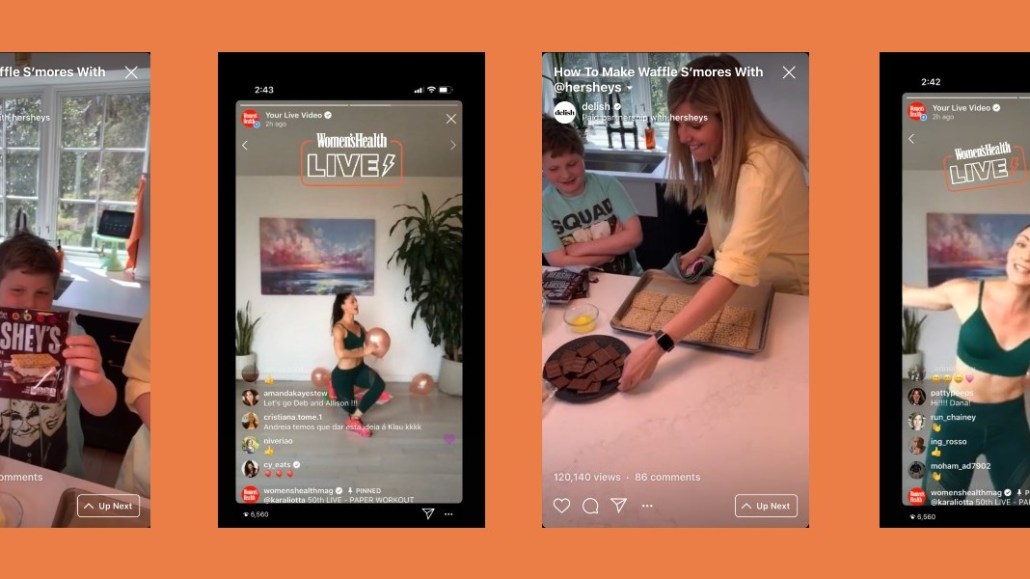
Despite the days running together during social distancing, on any given day you can tune into a set schedule of Instagram Live streams, hosted by 20 of Hearst Magazine’s titles.
Last month, Hearst hosted 80 live streams and so far in April, the publisher is on track to have an average of more than 50 live streams per week across its brands’ social channels.
At 10 a.m. ET, you can start your day with a live interview between Elle Decor editor-in-chief Whitney Robinson and well known interior designers while sneaking a peek inside their homes. At noon, you have your choice of working out with fitness trainers on Men’s Health’s or Women’s Health’s channels. At 1 p.m., you can make lunch alongside Delish’s editorial director Joanna Saltz and her kids. And to wind down at 9 p.m., you can go to Prevention’s channel and follow a guided meditation.
Hearst Magazines’ brands are testing everything from tune-in alerts and main feed posts with the week’s schedule of programming in order to build a returning audience. They are also using countdown sticker integrations in their Stories. One of Hearst’s brands — Delish — has attracted sponsorship revenue too, though monetizing Instagram Live remains difficult.
“We want to make it a habit and feel like appointment viewing,” said Kristine Brabson, executive director of content strategy at Hearst Magazines. “These are not viral hits and we don’t go into it thinking it will be a viral hit.”
Instead, Brabson said, the goal is more about “how can we build up a core engaged audience” that has the expectation of tuning into the brand’s channel at the same time everyday.
On March 17, coinciding with the unofficial start of social distancing, Women’s Health tapped its portfolio of fitness influencers and trainers and started live streaming workouts. Then, after receiving a boost of engagement — WH’s increased its number of followers by more than 44,000 in March, bringing its total to 1.9 million followers, according to CrowdTangle — on March 21 the brand increased frequency of the workouts to twice daily and just recently completed its 50th episode this week, Brabson said.
The other way that Brabson said the company has been marketing its Instagram Live streams is by using the celebrities’ and trainers’ Instagram stories and pages to promote the episodes that they are in, leveraging the thousands or millions of followers that they have themselves.
Elle tested this celebrity model with a series called “Quarantine & Chill,” and had “Love is Blind’ reality stars Lauren Speed and Cameron Hamilton give social distancing dating advice in a Q&A style video. Prior to the stream, the couple filmed a promo video to use on their channels and in the brand’s Story to build awareness, which brought in 22,000 live viewers and a total of 36,000 viewers who watched within the 24 hours of going live.
O, The Oprah Magazine also used its namesake, Oprah Winfrey, for an interview-style stream with digital director Arianna Davis, which ended up bringing in 74,000 viewers during the live video.
25,000 views is classified on the higher end for what publishers typically see on Instagram Live streams, according to Benjamin Arnold, managing director of social media agency We Are Social.
Delish’s “#CookingTogether” live series, which features editorial director Saltz leading a kids and parents cooking class with her own children, has been bringing in an average of 15,000 to 20,000 viewers per episode over the past three weeks. Its channel has more than 2.2 million followers and in March, it gained 67,000 followers, according to CrowdTangle. Based on this engagement level, the brand is looking to create a similar-in-concept YouTube series post-quarantine once it loses its real-time audience.
This series has also achieved monetization. Chocolate manufacturer Hershey’s bought a sponsorship for an episode of “#CookingTogether,” which featured product integrations within the recipe, and it is currently in the process of booking a second episode, according to Brabson.
Prior to the coronavirus, Alexa Tonner, co-founder of influencer marketing agency Collectively, said that both brands and influencers had not seen a huge adoption of Instagram live because the platform was tough to ensure an audience that would to tune-in at a single time every day. Therefore, it was an unnatural environment for publishers to be on.
“For it to continue as a viable medium beyond this moment in time, it has to be more publisher friendly and creator friendly,” said Tonner. “It comes down to monetization” beyond the sponsorship model, such as the ability to tip creators during the streams à la Twitch.
More in Media

Media Briefing: The top trends in the media industry for 2025
This week’s Media Briefing takes a look at the top trends from 2025, from digital advertising revenue performance to AI licensing deals.

Digiday Scorecard: Publishers rate Big Tech’s AI licensing deals
Digiday has compiled a scorecard grading AI platforms to make sense of the growing number of players in the AI content licensing market.

Publishers are hunting for AI prompt data — now they’re starting to get it from third-party companies
Publishers are finally gaining some visibility into AI search, as new prompt data tools crack open a black box.





